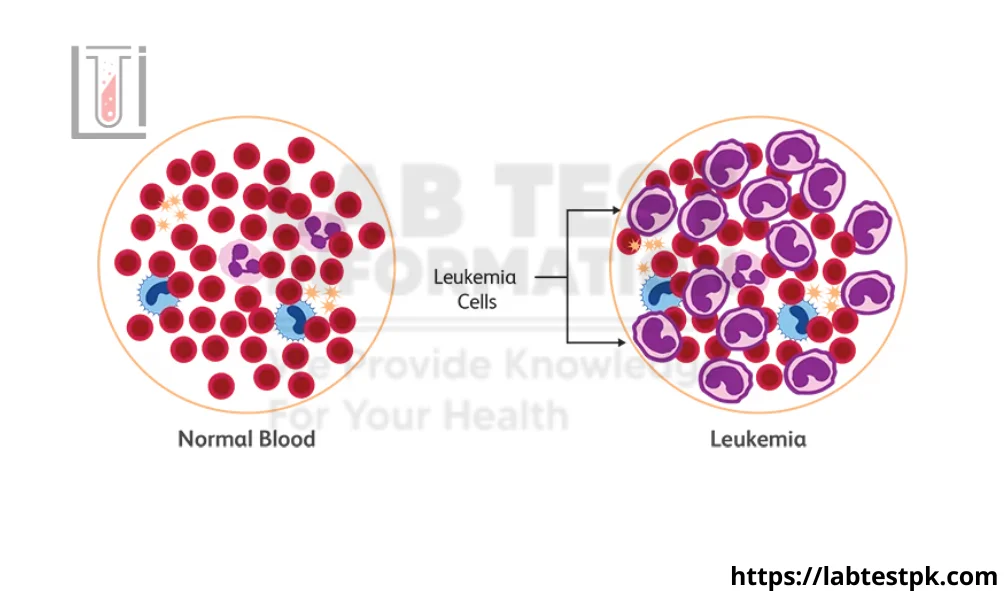Acute Leukaemia Panel, An Acute Leukemia Panel typically refers to a set of laboratory tests and procedures used to diagnose and characterize acute leukemia, a type of cancer that affects the blood and bone marrow. This panel is crucial for identifying the specific type of leukemia and determining the appropriate treatment plan. Here are some common components of an Acute Leukemia Panel:
Acute Leukaemia Panel
-
Acute Leukaemia PanelAcute Leukaemia Panel (CBC):
This test provides information about the number and types of blood cells, including red blood cells, white blood cells, and platelets. -
Peripheral Blood Smear:
A microscopic examination of a stained blood sample to assess the morphology and distribution of blood cells. -
Bone Marrow Aspiration and Biopsy:
These procedures involve taking samples of bone marrow from the hipbone or sternum to examine the cells and structure of the bone marrow. This is crucial for diagnosing leukemia and determining its subtype. -
Flow Cytometry:
This technique is used to analyze the characteristics of individual cells, especially white blood cells, based on the light they scatter. It helps identify specific cell markers and determine the type of leukemia. -
Cytogenetic Analysis:
This test examines the chromosomes in leukemia cells, identifying any abnormalities or genetic mutations. Certain chromosomal changes are associated with different types of leukemia and can impact prognosis and treatment decisions. -
Molecular Testing:
This involves analyzing specific genes or genetic mutations associated with leukemia. Common tests include polymerase chain reaction (PCR) and fluorescent in situ hybridization (FISH). -
Immunophenotyping:
This technique identifies cell surface markers on leukemia cells, helping to classify the type of leukemia and determine its aggressiveness. - Lumbar Puncture (if indicated): In some cases, a lumbar puncture may be performed to check for the presence of leukemia cells in the cerebrospinal fluid, as leukemia can sometimes involve the central nervous system.
These tests collectively provide a comprehensive understanding of the type and characteristics of acute leukemia.
Causes of Leukaemia:
Leukemia is a type of cancer that affects the blood and bone marrow, resulting in the overproduction of abnormal white blood cells. Leukemia development is greatly influenced by some key factors.:
-
Genetic Factors:
-
Genetic Mutations:
Changes in the DNA of bone marrow cells can lead to the development of leukemia. Some people may inherit genetic mutations that increase their risk of developing the disease. -
Family History:
Individuals with a family history of leukemia may have a higher risk, suggesting a genetic predisposition.
-
-
Environmental Factors:
-
Exposure to Radiation:
Prolonged exposure to high levels of ionizing radiation, such as radiation therapy or nuclear accidents, is a known risk factor for leukemia. -
Chemical Exposure:
Certain chemicals, such as benzene and certain chemotherapy drugs, increase the risk of leukemia. Taking measures to greatly reduce exposure to these chemicals can help lower the risk of developing the disease. -
Cigarette Smoking:
Smoking greatly increases the risk of developing acute myeloid leukemia (AML). - Certain Viral Infections: Infections with certain viruses, such as human T-cell lymphotropic virus (HTLV-1) or Epstein-Barr virus (
- ), have been linked to the development of leukemia.
-
-
Medical Factors:
-
Previous Cancer Treatment:
Individuals who have undergone certain cancer treatments, such as chemotherapy or radiation therapy, may have an increased risk of developing leukemia as a secondary cancer. -
Certain Blood Disorders:
Some pre-existing blood disorders, such as - (MDS), are associated with an elevated risk of leukemia.
-
-
Genetic Syndromes:
-
Down Syndrome:
Children with Down syndrome have an increased risk of developing leukemia, particularly acute lymphoblastic leukemia (ALL). -
Other Genetic Syndromes:
Certain genetic disorders, such as Fanconi anemia and Bloom syndrome, greatly reduce the risk of leukemia.
-
Cell type:
-
Acute Lymphoblastic Leukemia (ALL):
- Cell Type: Immature lymphocytes (a type of white blood cell) multiply rapidly and accumulate in the bone marrow and blood.
-
Chronic Lymphocytic Leukemia (CLL):
- Cell Type: Mature but abnormal lymphocytes accumulate in the blood, bone marrow, and lymph nodes.
-
Acute Myeloid Leukemia (AML):
- Cell Type: Immature myeloid cells (precursors of red blood cells, platelets, and other types of white blood cells) proliferate uncontrollably.
-
Chronic Myeloid Leukemia (CML):
- Cell Type: Abnormal myeloid cells, particularly granulocytes, accumulate in the blood and bone marrow.
Procedure:
You must follow the steps and supply the sample:
- 5 mL of blood
- 2 smears of peripheral blood
- 4 mL of bone marrow
- 4 smears of bone marrow


[…] Puncture, In the realm of medical procedures, lumbar puncture, commonly known as a spinal tap, emerges as a crucial diagnostic tool. This intricate technique […]
[…] method used to assess the risk of certain chromosomal abnormalities in a fetus, particularly Down syndrome (Trisomy 21), Edwards syndrome (Trisomy 18), and Patau syndrome (Trisomy 13). It combines three […]
[…] treatments to an individual’s genetic profile. It allows for more precise diagnosis, prognosis, and selection of therapies based on genetic factors, improving treatment outcomes and reducing […]
[…] those over the age of 35, to undergo prenatal screening and testing to assess the risk of chromosomal abnormalities such as trisomy […]
[…] and is caused by various viruses. It’s usually less severe than bacterial meningitis. Viruses that can cause viral meningitis […]
[…] antibody tests: These tests look for specific antibodies to EBV, including IgM and IgG antibodies. IgM antibodies usually indicate a recent infection, while IgG […]
[…] immune system due to organ transplant, chemotherapy, or chronic corticosteroid […]